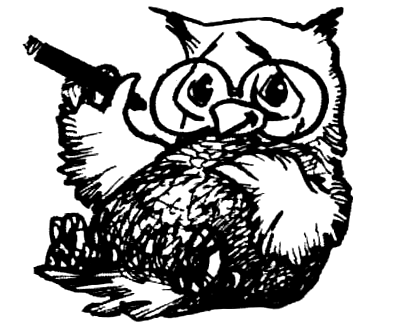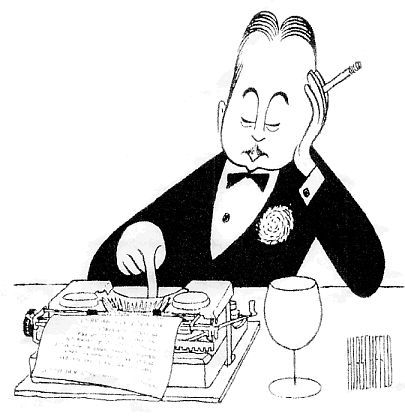What is this rule? you may ask.
Go ahead and ask it.
Very well, since you ask.
It is a rule which has kept J.P. Morgan what he is. It is a rule which gives John D. Rockefeller the right to be known as the Baptist man alive. It is a rule which is responsible for the continued existence of every successful man of today.
And now I am going to tell it to you.
You, the you that you know, the real you, are going to learn the secret.
Can you bear it?
Here it is:
You can’t win if you breathe under water.
Read that again.
Read it backward.
It may sound simple to you now. You may say to yourself, “What do you take me for, a baby boy?”
Well, you paid good money for this book, didn’t you?
LV—THE CATALOGUE SCHOOL
Without wishing in the least to detract from the praise due to Sinclair Lewis for the remarkable accuracy with which he reports details in his “Main Street,” it is interesting to speculate on how other books might have read had their authors had Mr. Lewis’s flair for minutiae and their publishers enough paper to print the result.
For instance, Carol Kennicott, the heroine, whenever she is overtaken by an emotional scene, is given to looking out at the nearest window to hide her feelings, whereupon the author goes to great lengths to describe just exactly what came within her range of vision. Nothing escapes him, even to shreds of excelsior lying on the ground in back of Howland & Gould’s grocery store.
Let us suppose that Harriet Beecher Stowe had been endowed with Mr. Lewis’s gift for reporting and had indulged herself in it to the extent of the following in “Uncle Tom’s Cabin:”
“Slowly Simon Legree raised his whip-arm to strike the prostrate body of the old negro. As he did so his eye wandered across the plantation to the slaves’ quarters which crouched blistering in the sun. Cowed as they were, as only ramshackle buildings can be cowed, they presented their gray boards, each eaten with four or five knot-holes, to the elements in abject submission. The door of one hung loose by a rust-encased hinge, of which only one screw remained on duty, and that by sheer willpower of two or three threads. Legree could not quite make out how many threads there were on the screw, but he guessed, and Simon Legree’s guess was nearly always right. On the ground at the threshold lay a banjo G string, curled like a blond snake ready to strike at the reddish, brown inner husk of a nut of some sort which was blowing about within reach. There were also several crumbs of corn-pone, well-done, a shred of tobacco which had fallen from the pipe of some negro slave before the fire had consumed more than its very tip, an old shoe which had, Legree noticed by the maker’s name, been bought in Boston in its palmier days, doubtless by a Yankee cousin of one of Uncle Tom’s former owners, and an indiscriminate pile of old second editions of a Richmond newspaper, sweet-potato peelings and seeds of unripe watermelons.

